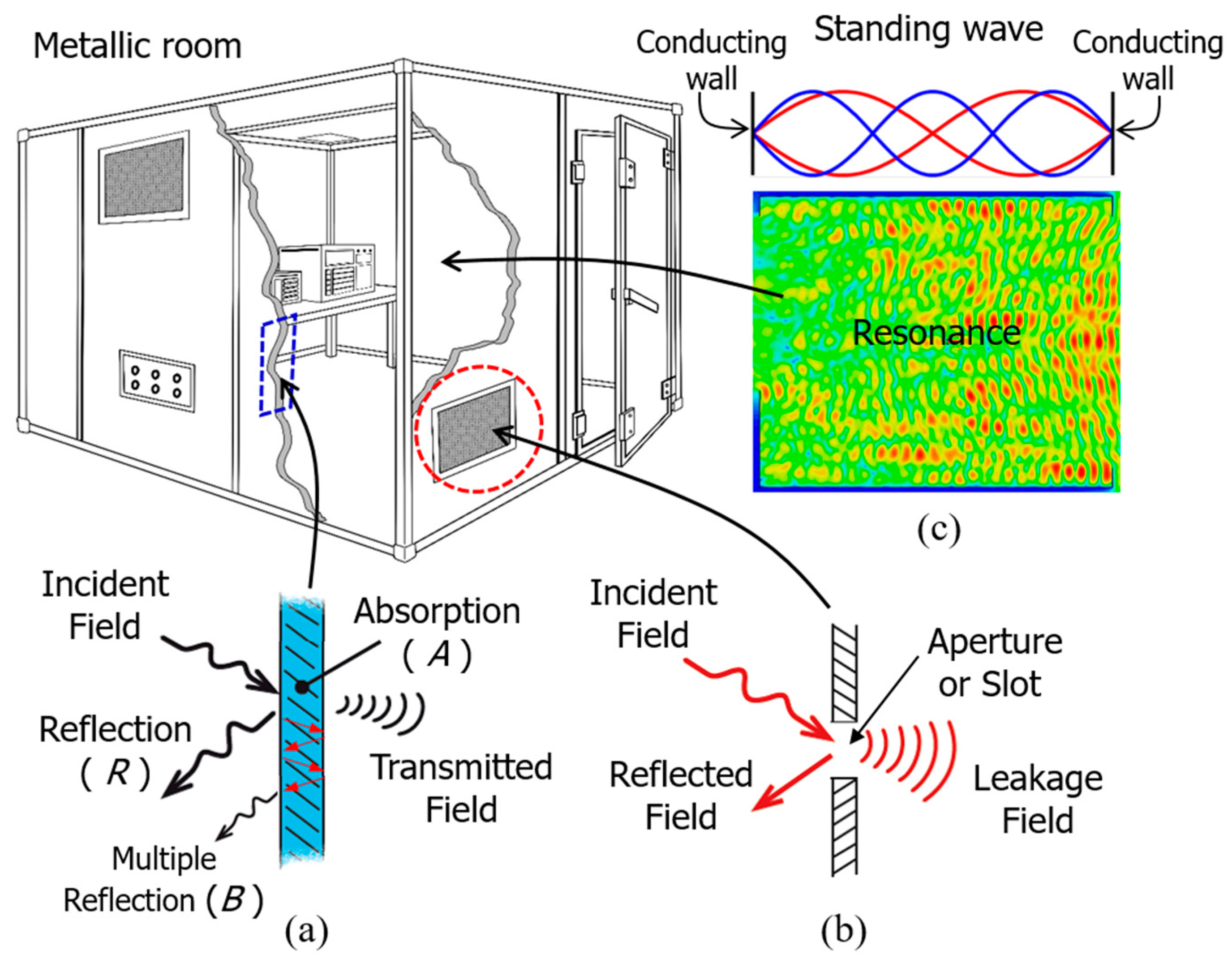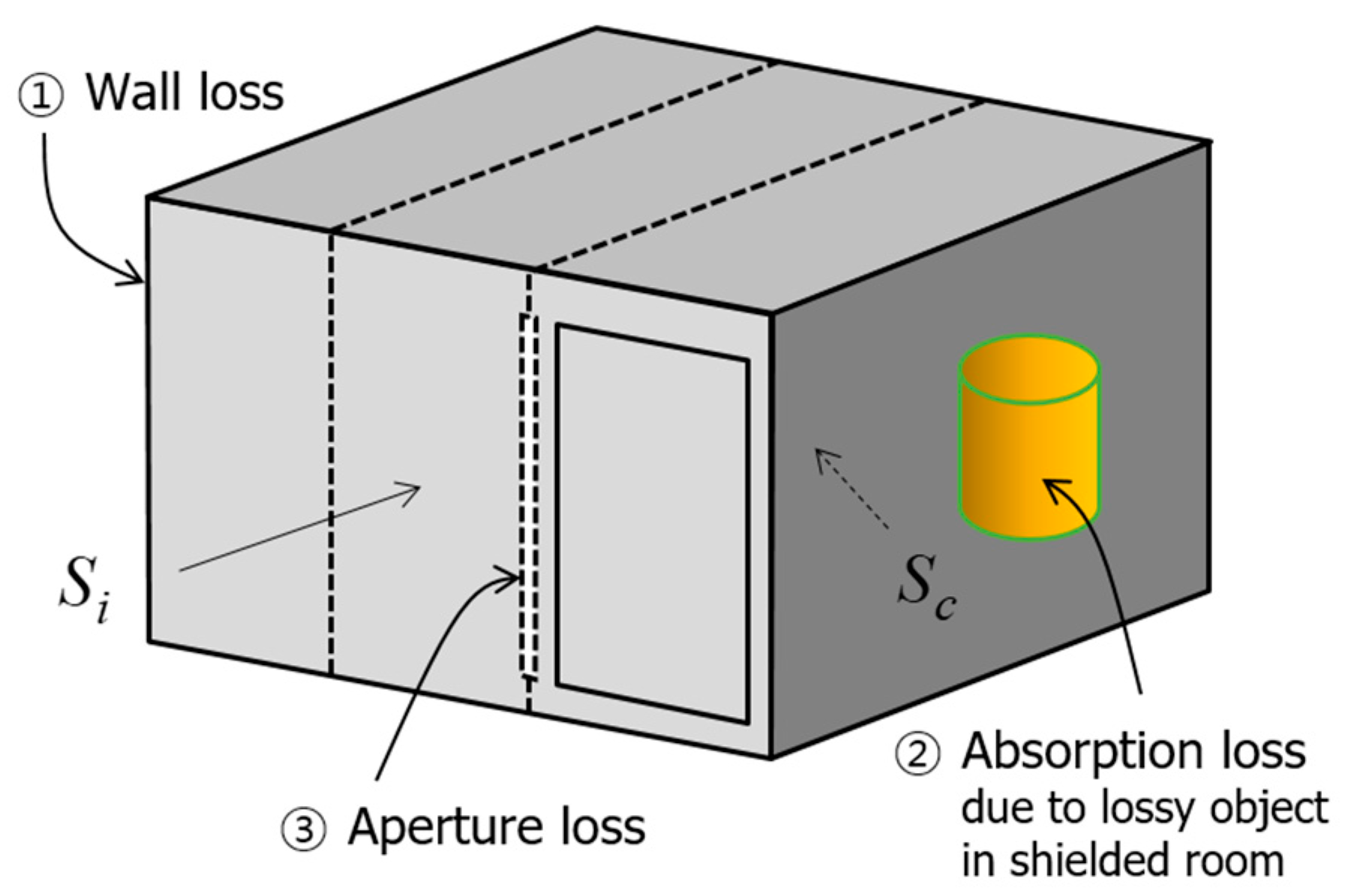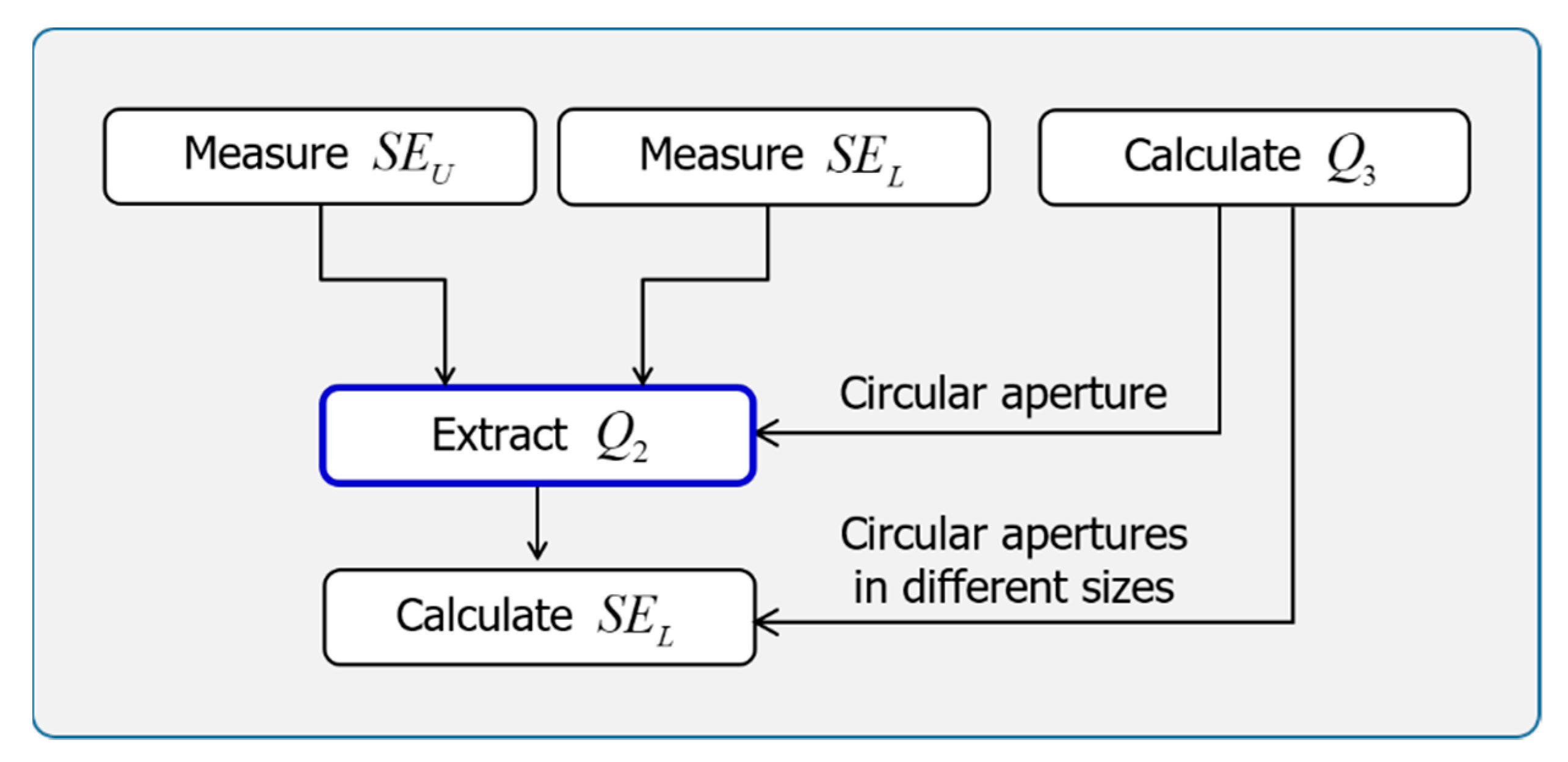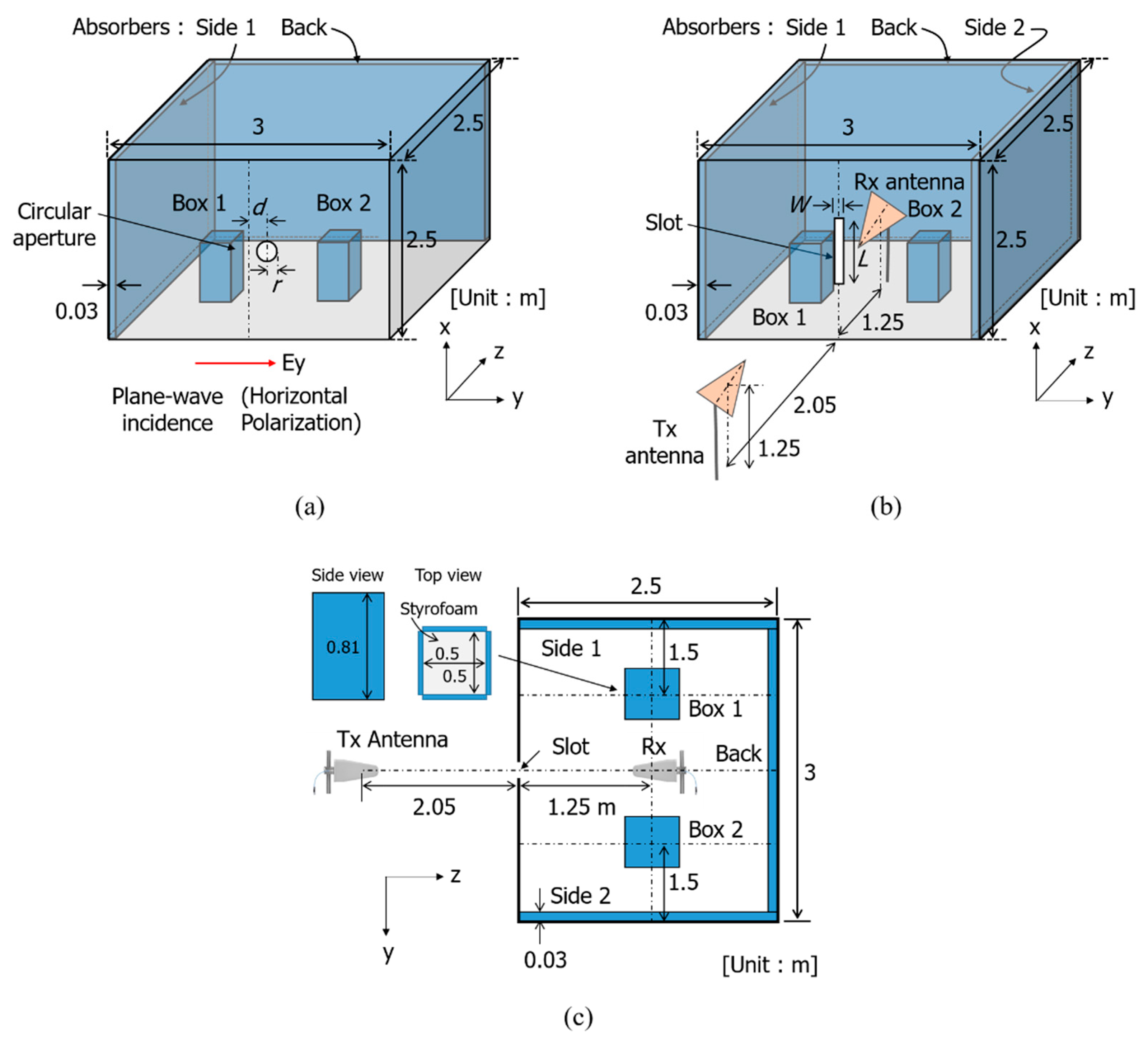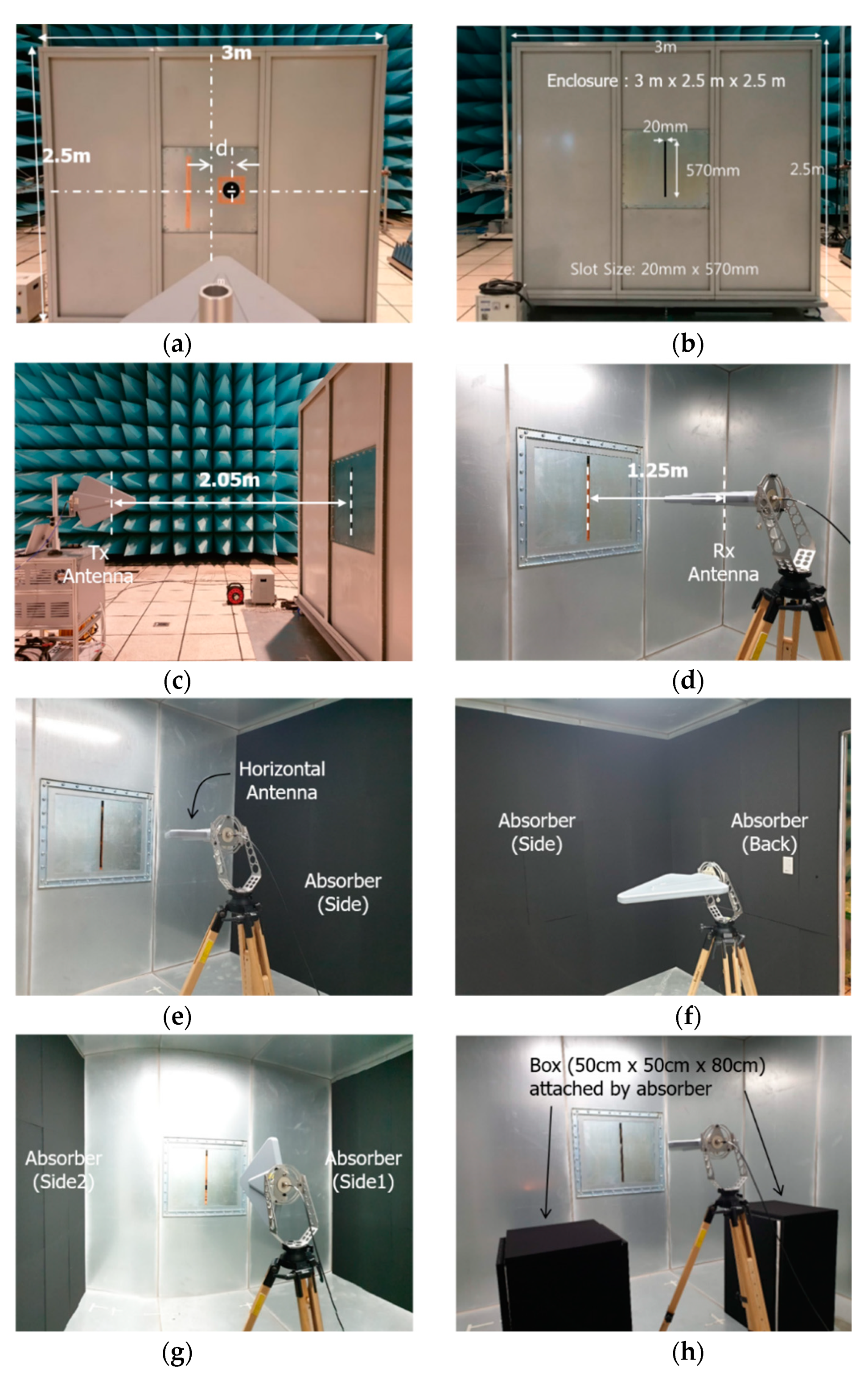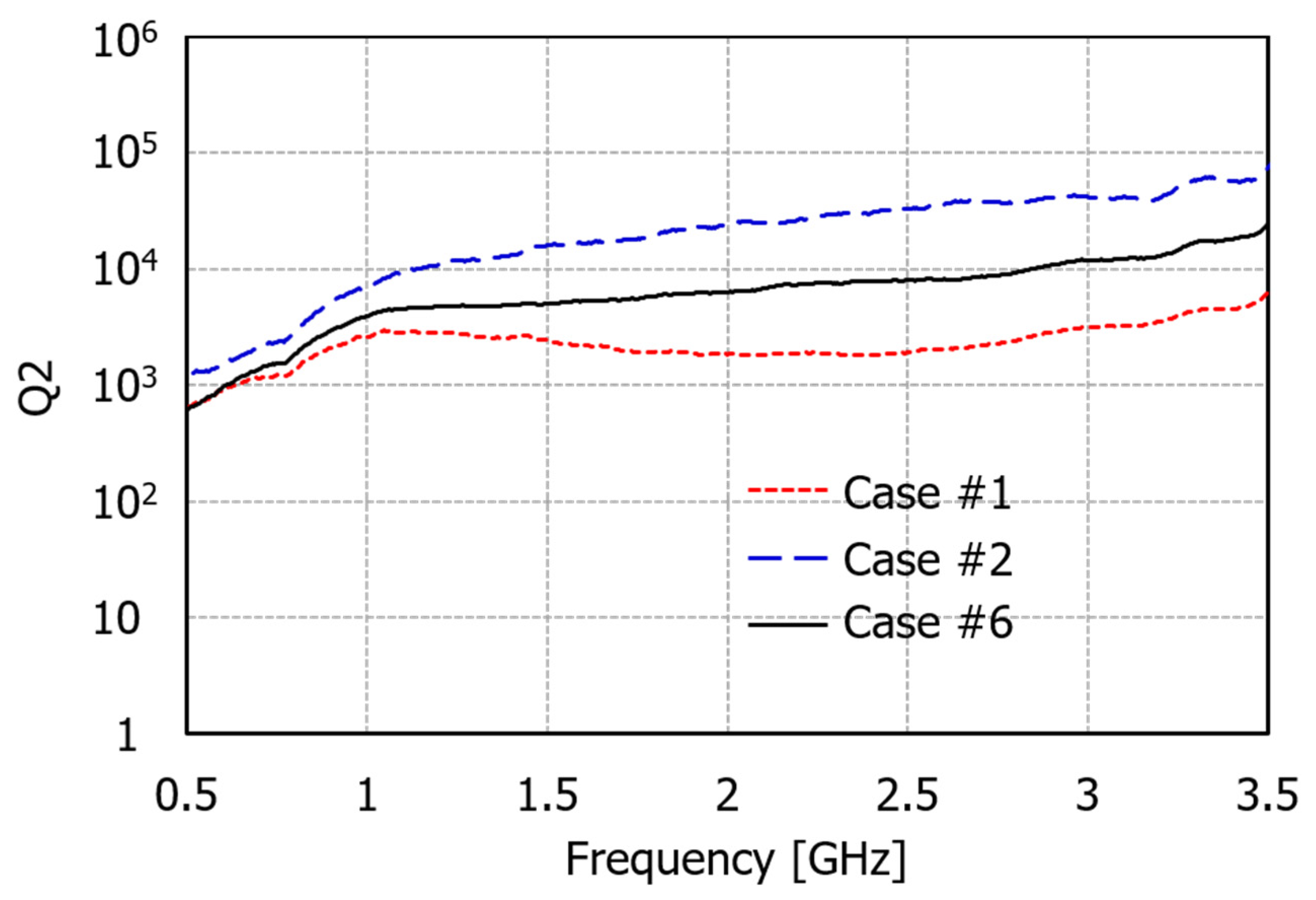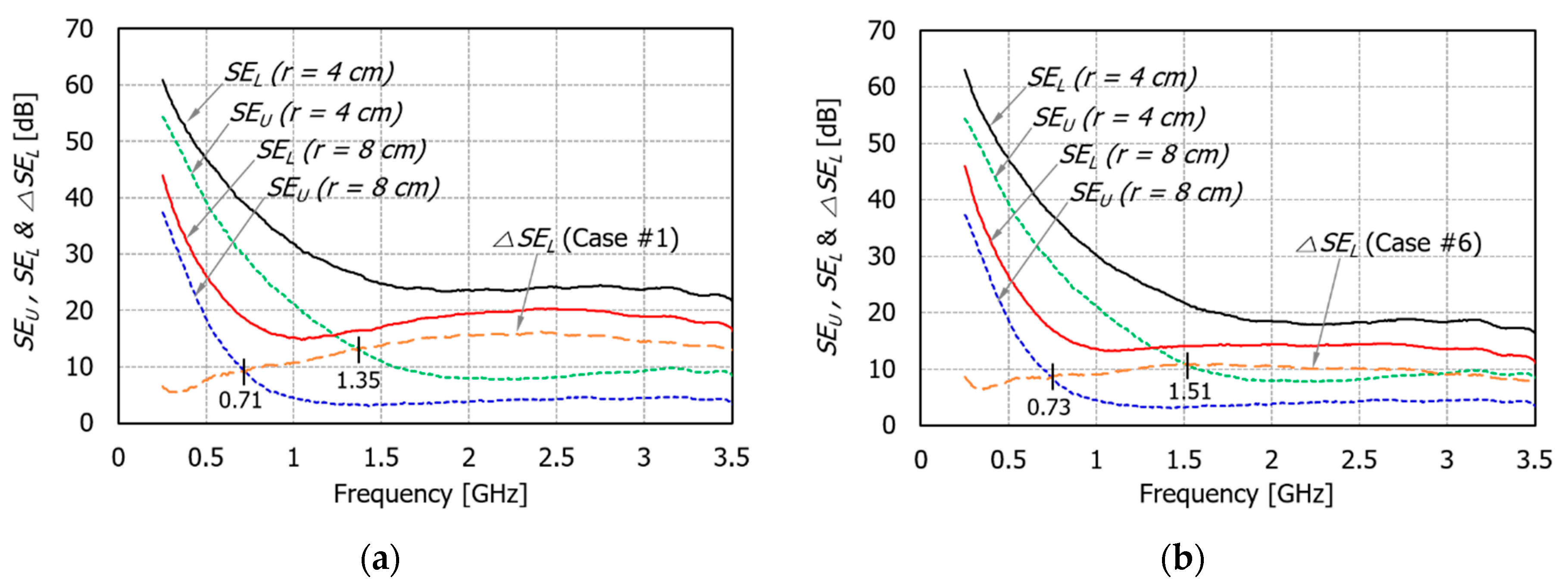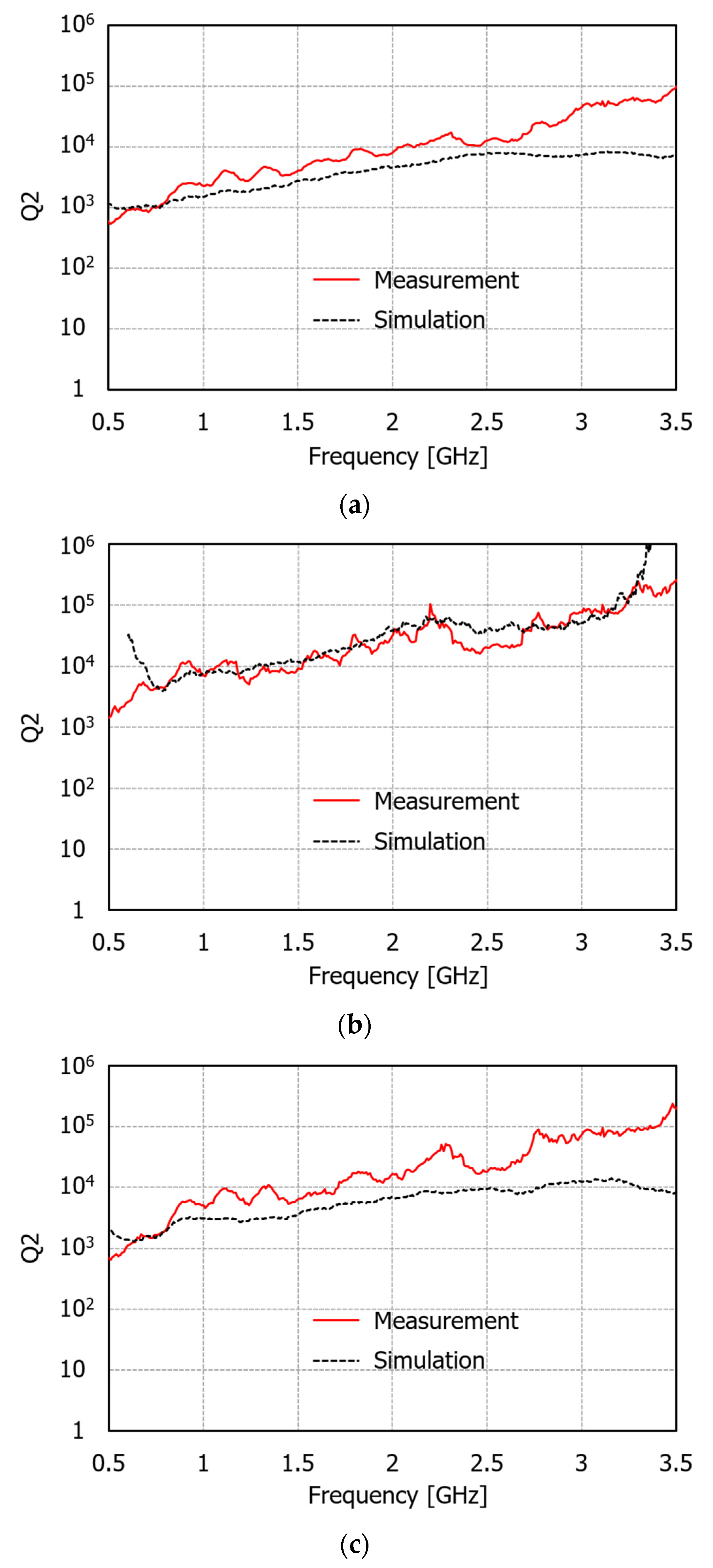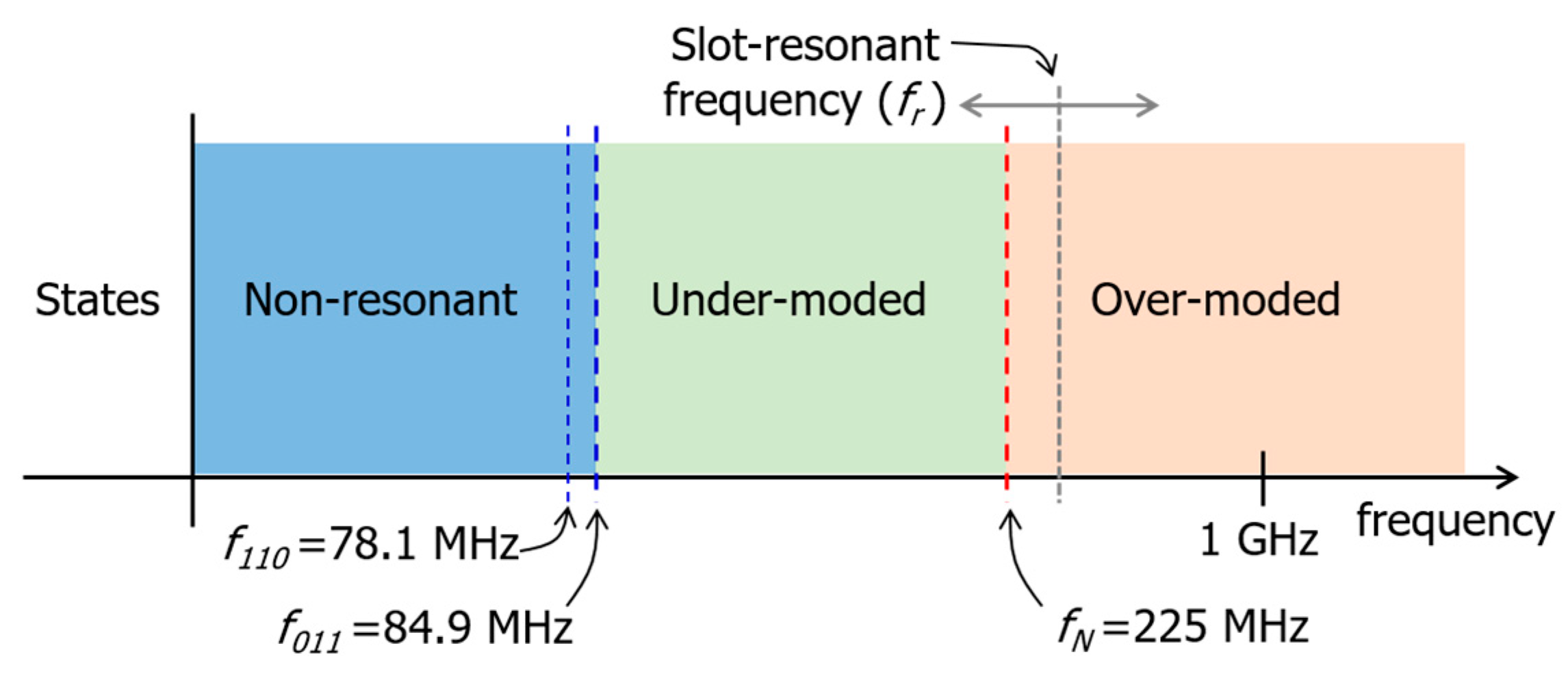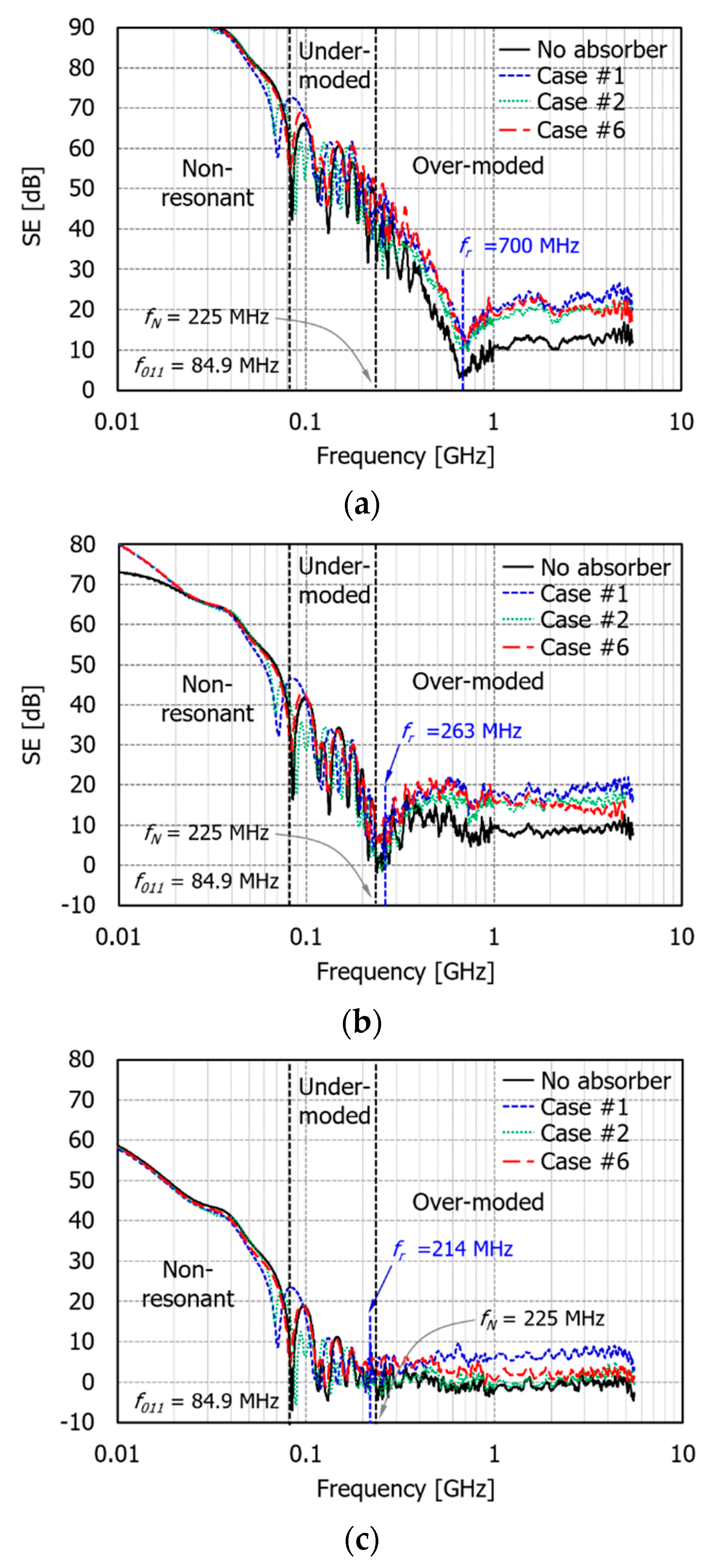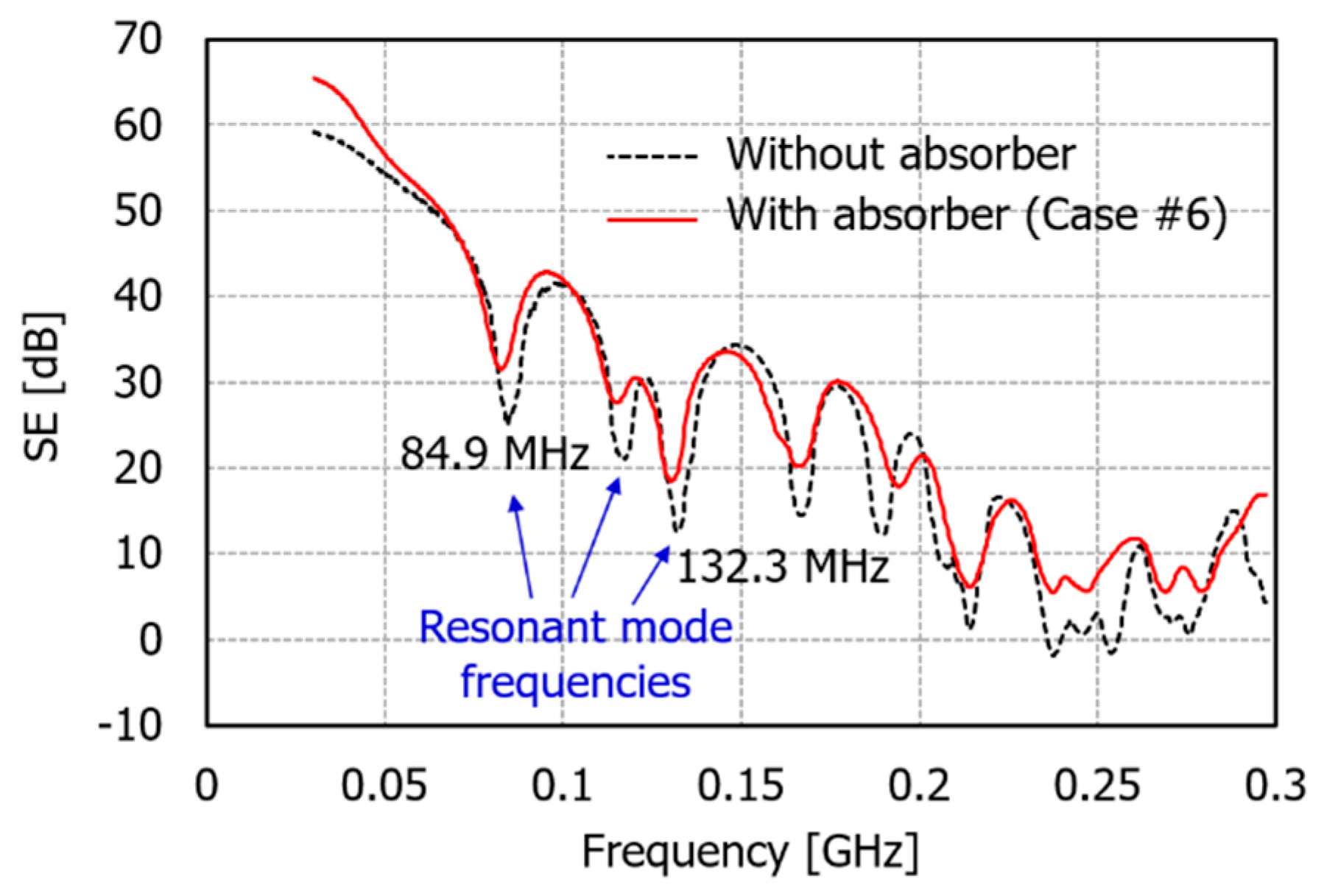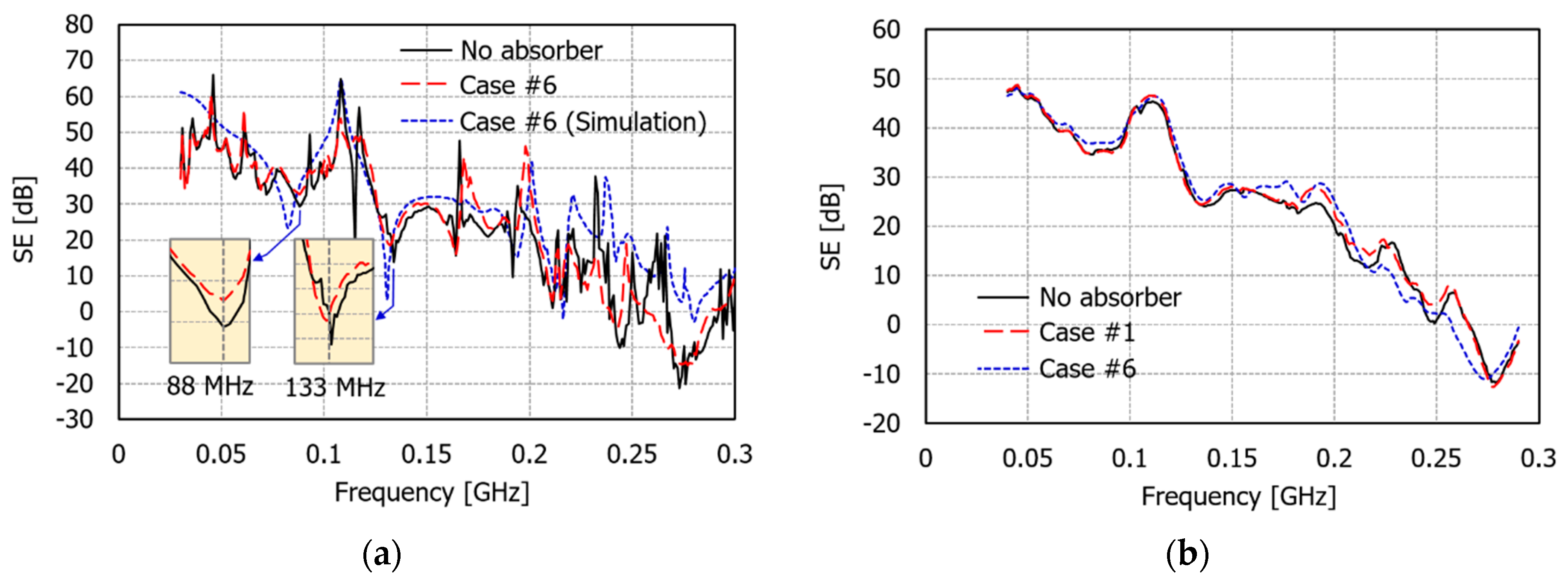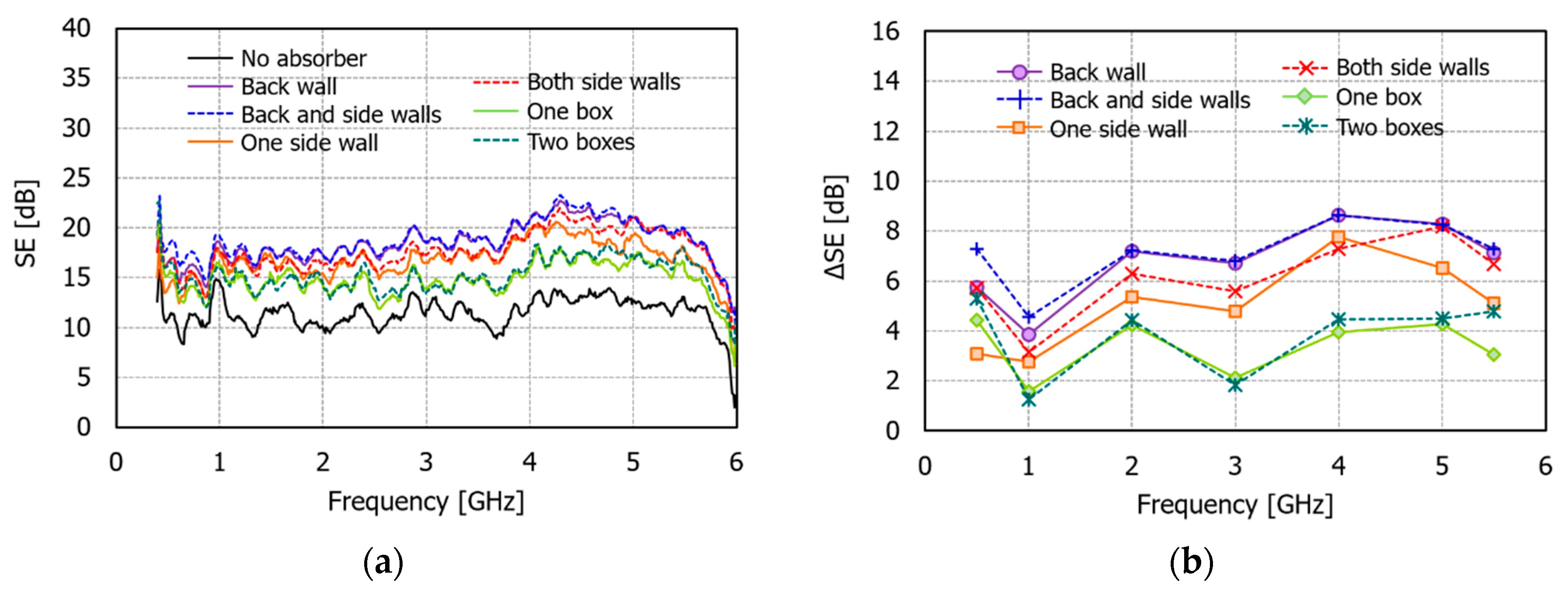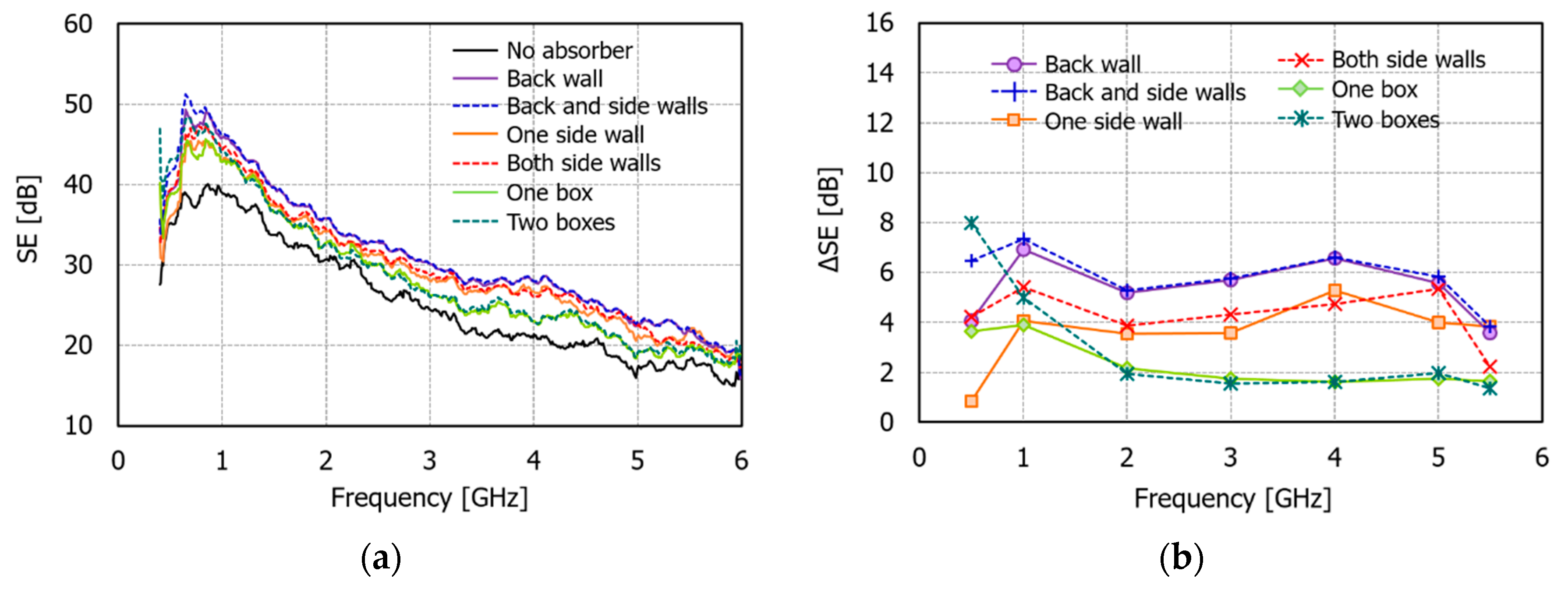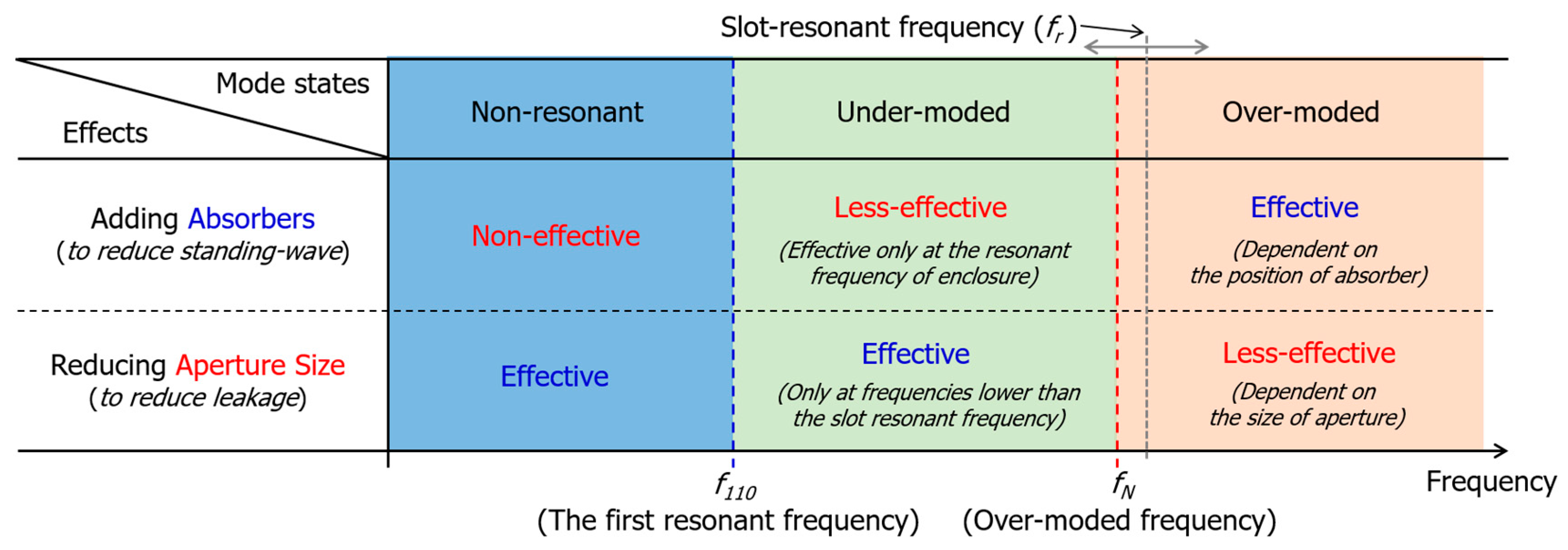4.1. Extraction of and Its Contribution to the SE
Figure 6 shows the extracted
of absorbers at three positions (cases #1, #2, and #6 in
Table 1). As shown in
Figure 4a, when the horizontally polarized plane-wave is incident, the SEs of the shielded room with and without each absorber were calculated at the frequency range from 500 MHz to 3.5 GHz by the numerical simulation. Moreover, the simulated SEs were provided to Equation (6) and
was calculated according to the three positions of the absorbers. In this case, a circular aperture of
r = 8 cm was used to analytically calculate
of the aperture loss. The simulated results in
Figure 6 show that absorbers with different positions and shapes have different
, resulting in different impacts on SE improvement. The lowest
was seen when the absorber was on the back wall (case #1), while the highest
was shown for the side absorber (case #2). The
of two cuboid absorbers on the floor (case #6) had an intermediate value of the other two cases. The smaller
indicates higher absorption and SE improvement.
To examine quantitatively how much the absorbers in the shielded room improves its
,
without absorber,
with absorber, and
in Equation (9) were calculated by simulation.
Figure 7 shows the SEs with and without absorbers (
and
) in the shielded room with each circular aperture of 4 cm and 8 cm in radius. For the absorbers in two cases (cases #1 and #6), the
in Equation (9) was also plotted. Similar to the shielding properties of typical metallic enclosures with apertures, the simulated SEs are high at a low-frequency and gradually decreases as the frequency increases. At a high-frequency above 2 GHz, the decrease of SE is not noticeable. In addition, if there is an absorber in the shielded room, the SE increases by
.
In
Figure 7a, the SE improvement is examined when the absorber is on the back wall (case #1). When there is no absorber in the shielded room with a circular aperture of an 8 cm radius, the SE is about 5 dB at frequencies above 1 GHz. However, when loading the absorber, the SE increases to 15~20 dB at the same frequency range. When comparing
and
,
starts to become larger than
from a frequency of 0.71 GHz. It can be said that the influence of the absorber on the SE starts to become dominant from 0.71 GHz. If the radius of the circular aperture is reduced from 8 cm to 4 cm, the SE of the shielded room without absorber increases by about 3 to 5 dB above 1.5 GHz. Of course, it increased by 15~20 dB at lower frequencies. This means that the size of the aperture has a greater influence on the SE at lower frequencies. When there is an absorber, it can be seen that the SE is about 25 dB at a frequency of 1.5 GHz or higher. When comparing
and
,
starts to become larger than
from 1.35 GHz. Therefore, even if the same absorber is used, the frequency at which the influence of the absorber begins to occur dominantly on the SE varies depending on the SE level determined by the aperture on the shielded room. In other words, as the SE of the shielded room by the aperture is lowered, the SE improvement by the absorber starts to appear from the lower frequency.
In
Figure 7b, the SE improvement is analyzed when two cuboid absorbers are on the floor (case #6). Since
case #6 was greater than
of case #1 shown in
Figure 6, it can be seen that
case #6 has a lower value than that of case #1. As a result, the frequency at which
is greater than
is 0.73 GHz for a circular aperture with
r = 8 cm, and 1.51 GHz for a circular aperture with
r = 4 cm. These frequencies are more increased than those of case #1. In addition, improvement is also reduced when compared to case #1. Therefore, the lower the loss of the absorber, the higher the frequency at which the absorber starts to dominantly affect the SE improvement. Consequently, it can be seen that the contribution of the absorber in the shielded room to the SE improvement depends on the SE of the shielded room by the aperture as well as the position of the absorber. In addition, the SE improvement by the absorber is greater at high frequencies than low frequencies, where the influence of the aperture on the SE is dominant.
In order to verify the simulated results in
Figure 6, we compared the simulated
with the measured one in
Figure 8. Strictly speaking, the measured
indicates the
obtained through the measured SEs of the shielded room using the antenna excitation with horizontal polarization. The measurement setup is already shown in
Figure 5a. In addition, the simulated
was also obtained through the simulated SEs using the antenna excitation. As can be seen in
Figure 8, if the absorber was placed on the back or floor (cases #1 and #6), the measured
was larger than the simulated one and the difference between them gradually increased as the frequency increased. In particular, the difference between simulated and measured results seemed to be a little larger because the structure of absorbers in case #6 was not exactly the same in simulation and measurement. However, it can be seen that the measured and simulated
agree well with the absorber lying on the side wall.
4.2. Effect of Absorbers on the SE in Terms of Mode Density
As a second analysis, the effect of the absorber on the SE was investigated in terms of the nonresonant, under-moded, and over-moded states in the shielded room. For this, we analyzed the SE for the shielded room with a long slot by the numerical simulation and measurement, as shown in
Figure 4b and
Figure 5b, respectively.
Before discussing the analysis results, the frequency of the first resonant mode and the over-moded frequency of the metallic shielded room used in this study are first calculated. Here, the over-moded frequency is defined as the frequency at which the number of resonant modes becomes more than 60 inside the shielded room [
23]. The first resonant frequency of the rectangular enclosure usually occurs at (110) mode. In the case of the shielded room used here,
= 78.1 MHz. However, the first resonant mode in which the incident electric field is parallel to the long direction of the enclosure actually occurs at the (011) mode, and its frequency is
= 84.9 MHz. The over-moded frequency is calculated by using the formula shown in [
23] and
= 225 MHz. Therefore, as shown in
Figure 9, three mode states can be defined based on these two frequencies. In the frequency range lower than 84.9 MHz, the shielded room is in a non-resonant state. The shielded room is in an over-moded state at the frequency range above 225 MHz. In the frequency range from 84.9 MHz to 225 MHz, the shielded room can be defined as an under-moded state. Therefore, we can analyze the change of SE according to the absorber in three frequency ranges corresponding to each mode state.
Figure 10 shows the simulation results of SE at the frequency range from 10 MHz to 6 GHz in the presence or absence of absorbers in the shielded room with three different slots. The sizes (
L × W) of three different slots are 0.2 m × 0.02 m (slot #1), 0.57 m × 0.02 m (slot #2), and 0.7 m × 0.7 m (slot #3). The resonant frequency of each slot is simply calculated by
, where
c is the speed of light in free space. The absorbers are also the same as the structure examined earlier (cases #1, #2, and #6). A plane-wave with horizontal polarization is incident, and then the SE is calculated by spatially averaging the electric field values at 72 positions in the shielded room. Note that the resonance occurs very densely in the over-moded frequency range, and an SE with very severe fluctuation is obtained even if the spatially averaging is performed. This makes it difficult to accurately distinguish the SE improvement depending on the absorber. To resolve this matter in the over-moded frequency range, the moving average in the frequency domain was applied to the spatially averaged electric field to get a smoother SE curve.
When the slot size is 0.2 m × 0.02 m (slot #1), the slot resonance occurs at around 700 MHz, as shown in
Figure 10a. In this case, the slot resonant frequency is placed in the over-moded frequency range. When the slot size is 0.57 m × 0.02 m (slot #2), the resonant frequency of the slot is 263 MHz, as shown in
Figure 10b, which lies around the over-moded frequency (225 MHz). When the slot size is 0.7 m × 0.7 m (slot #3), the resonant frequency of the slot is 214 MHz, as shown in
Figure 10c, which lies in the under-moded frequency range.
Looking at the change of SE according to the frequency in
Figure 10, the SE generally decreases as the frequency increases up to the slot resonant frequency. However, at frequencies higher than the slot resonant frequency, the SE does not decrease significantly and has an almost constant level. This phenomenon is the same, even if the slot size is different. In the non-resonant frequency range, it can be seen that the SE is not changed by the presence of an absorber. This means that in the low-frequency range at the nonresonant state of the shielded room, the SE is not improved by the absorber in the shielded room. In the under-moded frequency range, the resonance mode starts to occur one-by-one, and the resonant frequency also changes according to the position of the absorber. Therefore, we can say the SE improvement by the absorber at a specific resonant frequency, but it is difficult to say that the overall level of SE was increased by the absorber. Further simulation and measurement in the under-moded frequency range are shown later, and a more detailed discussion is provided.
Lastly, let us look at the characteristic of the SE improvement by the absorber in the over-moded frequency range. In the case of slot #1 shown in
Figure 10a, since the slot resonant frequency is within the over-moded frequency range, we will consider the effect of the absorber by dividing the frequency range into higher and lower frequencies than the slot resonant frequency. First, in the frequency range higher than the slot resonant frequency (
> 700 MHz), the SE improvement by the absorber is clearly seen. When the absorber is on the back wall (case #1), the SE is improved by about 10 dB in the frequency range of 1 to 6 GHz. When the absorber is on the side wall (case #2), it is improved by around 6 to 8 dB at the same frequency range. In the case of two cuboid absorbers on the floor (case #6), the SE improvement is similar to case #1 at 1~2 GHz and case #2 at 2~6 GHz. Therefore, it can be seen that different improvement characteristics of SE are shown depending on the position of the absorber. These results are also consistent with the
results of the three absorbers shown in
Figure 6. At the frequencies lower than the slot resonant frequency (225 MHz <
< 700 MHz), it can be seen that the SE of the shielded room with the absorber has a higher value within 10 dB than that without the absorber. In addition, cases #1 and #6 have slightly higher SE values than case #2. Therefore, we can conclude that the SE improvement can be achieved by the absorber when the shielded room is in an over-moded state even at frequencies lower than the slot resonant frequency.
When the slot size is 0.57 m × 0.02 m (slot #2), as shown in
Figure 10b, it is meaningless to divide the over-moded frequency region based on the slot resonant frequency because the slot resonant frequency (263 MHz) and over-moded frequency (225 MHz) are similar. It can be seen that the SE of the shielded room with the absorber is improved by 6~10 dB in the over-moded frequency range. However, it is difficult to say that the overall SE is improved by the absorber in the under-moded range lower than the slot resonant frequency. When the slot size is 0.7 m × 0.7 m (slot #3) as shown in
Figure 10c, in the over-moded frequency range, when the absorber is in the back wall (case #1), the SE is improved by 5~8 dB in the frequency range above 500 MHz. In cases #2 and #6 of absorbers, the SE improvement was not significant. This is because if the size of the slot is too large, the intensity of the reverberating field in the shielded room is weakened, and then the field attenuation by the absorber is not great. Therefore, it can be seen that the degree of SE improvement by the absorber in the over-moded frequency range alters accordingly to the slot size of the shielded room.
In order to examine the SE improvement characteristics by the absorber at the under-moded frequency range in detail, the results of
Figure 10b were redrawn in
Figure 11 by expanding the frequency up to 300 MHz only. The SE results are compared with two cases: the presence and absence of two cuboid absorbers on the floor (case #6) in the shielded room with slot #2 (0.57 m × 0.02 m). Here, we can see that the SE of the shielded room is greatly reduced at the resonant mode frequencies. However, if there is the absorber of case #6, the amount of reduction decreases and then the SE is improved. In addition, it can be seen that SE is hardly improved by the absorber at frequencies other than the resonant mode frequencies. As a result, it can be said that in the under-moded frequency range, the SE is improved by the absorber only at the resonant frequencies of the shielded room, but the overall SE level is not improved.
In order to verify these results through an experiment, the SE was measured in the frequency range of 30~300 MHz using the structure in
Figure 4b and biconical antennas with horizontal polarization.
Figure 12 compares the measured SEs for the cases with and without two cuboid absorbers on the floor (case #6). For verification, the SE calculated using the simulated electric field at the center of the shielded room in the presence of the absorber was also plotted. First of all,
Figure 12a shows that the simulated result agrees relatively well with the measured SE. It can also be seen that the SE increases slightly at two resonant frequencies (88 MHz and 133 MHz) when there is the absorber (case #6). To check whether the SE is improved overall by the absorber in the under-moded frequency range,
Figure 12b shows the results of applying the moving average to the measured SEs in
Figure 12a. The measured SE of the absorber on the back wall (case #1) was also plotted. When comparing the measured SE without the absorber, it is difficult to say that the SE is improved by the absorber.
Next, the variation of the SE improvement by different absorbers in the over-moded frequency range was examined through measurement. The SE was measured in the frequency range of 400 MHz~6 GHz using the structure in
Figure 4b and log periodic antenna with both horizontal and vertical polarizations. The slot size of the shielded room is 0.57 m × 0.02 m (slot #2). The measurements were performed in all cases listed in
Table 1. As mentioned earlier, to show the degree of the SE improvement more clearly by each case in the over-moded frequency range, the SE was calculated by applying the central moving average to the original measured results with a very reverberant behavior.
Figure 13 shows the measured SE results of the shielded room in the presence of the horizontally polarized incident field. In
Figure 13b, the SE improvement values for the cases with absorbers compared to the SE of the room without absorbers are plotted as the frequency varies. First, the SE of the room without an absorber is 10~13 dB in
Figure 13a. For the cases of the room with absorbers, case #1 (back wall) and case #3 (back and side walls) had the highest SE with a maximum improvement of 8.6 dB at 4 GHz compared to the SE of the room in the absence of absorbers. Comparing these two cases in
Figure 13b, it can be seen that case #3 has a higher SE than case #1 in the frequency range below 2 GHz while having almost the same SE at frequencies above 2 GHz. As a result, applying the absorbers only to the back wall can achieve a sufficient improvement in the SE. However, if it is needed to be improved further at a lower frequency, an additional absorber should be attached to the side wall together with the back wall.
In cases where the absorbers were attached only to the side walls (cases #2 and #4), the SE was slightly lower than those attached to the back wall. When the absorber was on both sides, the SE was about 1~2 dB higher than that of the absorber on only one side, but the difference was not large. Therefore, attaching the absorbers only on one side could sufficiently reduce the standing-wave effect. In the case of the absorber in the box form (cases #5 and #6), the SE could be improved up to 4 dB compared with the case without the absorber. However, the improvement was less than the cases that the absorbers were attached to the back or side walls.
Figure 14 shows the measured SE results of the shielded room in the presence of the vertically polarized incident field. Compared with
Figure 13, the SE was higher in the case of vertical polarization. This was because the electric field penetrating through the slot was reduced if the electric field direction was the same as the axis of the long side of the slot. The degree of the SE improvement by the absorbers was slightly reduced compared to that of the horizontal polarization. However, there clearly was an SE improvement by the absorbers: cases #1 and #3 were about 6 dB, cases #2 and #4 were about 4 dB, and cases #5 and #6 were around 2 dB, as shown in
Figure 14b. The change of the shielding improvement effect according to the position of the absorbers was the same as the horizontal polarization.
Figure 15 and
Figure 16 show the comparison of measured and simulated SE results using the antenna excitation for the three cases of #1, #2, and #3. Although the simulation model was not exactly the same absorber as that used in the measurement [
26], it can be seen that the SEs of the measurement and the simulation correspond well at the frequency range up to around 3.5 GHz in both horizontal and vertical polarizations. The simulation results also showed slightly higher SEs in both polarizations if the absorber was on the back wall than if it was on the side wall. In particular, the difference occurring at the frequency range above 4 GHz seemed to be caused by the inaccuracy of the high-frequency model of the absorber used in the simulation. However, it can be seen that the measurement and simulation results presented in
Figure 15 and
Figure 16 were generally similar, although there are differences depending on the frequency. These results confirm the accuracy of the simulation and measurement results.
